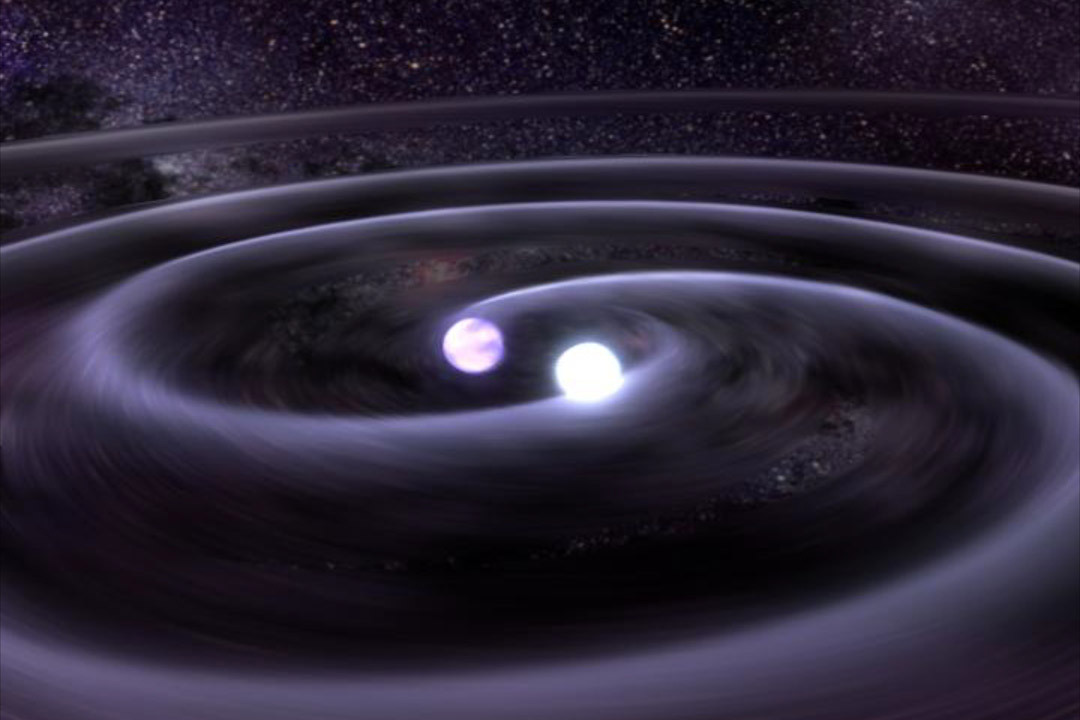Astronomers observe the approach of the stars of a binary system due to the emission of gravitational waves
The system is composed of two white dwarf stars that revolve around the common centre of mass every twenty minutes, and which are gradually approaching. The work, in which the Institute of Astrophysics of Andalusia (IAA-CSIC) participates, shows that the stars have “flattened out” and have an ellipsoidal shape due to the tidal forces
Every twenty minutes, the stars of the double system PTF J053332.05 + 020911.6 complete an orbit around the common centre of mass, a frequency that indicates that it is an exceptional system: it is not formed by "normal" stars, but by white dwarfs, and that speed generates tidal effects that deform the stars, which have an ellipsoidal shape. A work, with the participation of the Institute of Astrophysics of Andalusia (IAA-CSIC), has studied this system and has found that the stars show an orbital decay, which progressively approaches them, due to the emission of gravitational waves.
“We know that there is a direct relationship between the period of a star system and the distance between its components: the closer the stars are, the faster they orbit each other and, therefore, the shorter their period. And given that the period observed is so short, that implies that the stars are so close that they cannot be stars like the Sun, but more compact objects, as the analysis of the data showed”, says Antonio Claret, a researcher at the Institute of Astrophysics that participates in the study.
White dwarfs, such as those that form the PTF J053332.05 + 020911.6 system, constitute the remains of a star like the Sun that has expelled its outermost layers and retains a very compact core. The densities of these objects can amount to two tons per cubic centimeter, and can house a mass equivalent to that of the Sun in a volume similar to that of the Earth.
The white dwarf binary systems constitute an excellent laboratory to deepen the knowledge of the evolution of double stars, as well as the physics of the tides in astronomical environments but, likewise, a system like PTF J053332.05 + 020911.6 represents an ideal object for the study of gravitational waves, undulations in the spacetime predicted by Einstein.

Gravitational waves are a phenomenon associated with the objects that generate the most extreme gravitational environments, such as binary systems of white dwarfs, black holes or neutron stars. These systems generate distortions in spacetime that, like the waves produced by a stone in the water, propagate from the source at the speed of light, carrying valuable information about the objects that produce the waves and the nature of gravity.
“The observed orbital decay is due to the tidal forces that act in the system and the purely relativistic contribution. The approach of the two components makes them follow a spiral path emitting gravitational waves that can be detected in the future by the LISA space mission. The relativistic contribution in the reduction of the orbital period is of the order of 98% of the total -says Antonio Claret (IAA-CSIC)-. In addition, we have calculated both the distortions caused by the enormous tidal forces and the brightness distribution of the white dwarfs, which have an ellipsoidal shape”.
The work has also allowed us to glimpse the future of the system. The orbital decay, which causes a progressive approach of both stars, will reduce the time it takes to revolve around the common center of mass. When that period goes down from twenty to fourteen minutes, a mass transfer between the stars will begin, and they will end up merging, emitting a large amount of energy, or forming a system of cataclysmic variables, in which the transfer of matter produces intense peaks of variability.
K. B. Burdge et al. "Orbital Decay in a 20 Minute Orbital Period Detached Binary with a Hydrogen Poor Low Mass White Dwarf". The Astrophysical Journal Letters, ApJL 886 L12 (2019). DOI: 10.3847/2041-8213/ab53e5
Instituto de Astrofísica de Andalucía (IAA-CSIC)
Unidad de Divulgación y Comunicación
Silbia López de Lacalle - sll[arroba]iaa.es - 958230676
https://www.iaa.csic.es
https://divulgacion.iaa.csic.es

